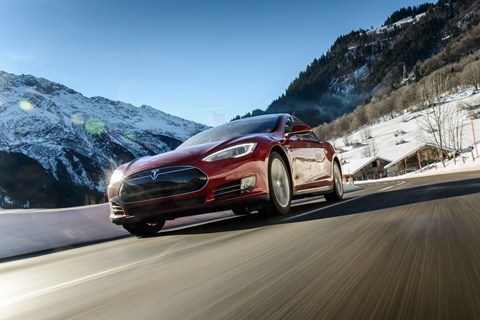► Latest Tesla over-the-air software update underway
► Includes autonomous lane-keeping and speed control
► Further ‘Autopilot’ enhancements planned for the future
Tesla has released its new, much-talked-about ‘Autopilot’ function, as part of an over-the-air software upgrade for the Model S saloon. The function is also applied to the brand-new Model X SUV.
The latest Version 7.0 software release, made available yesterday (14 October 2015) to as many as 60,000 Model S owners, enables the car to steer itself within a motorway lane and regulate its own speed according to surrounding traffic. The driver can command lane changes via a tap of the indicator stalk.
The UK’s best electric cars and EVs
So can Model S drivers catch a few Zs on the motorway now?
Well, no. Despite the title, Autopilot mode isn’t exactly fully autonomous driving – more a similar variation on the lane-keeping/switching, self-speed-regulating tech found in various existing production cars, including the likes of the Mercedes S-class and latest Audi A4. Tesla remains keen to bring a fully autonomous car to market in the near future – think of this initial Autopilot release as a first step on the way.
Rather than checking Twitter and tucking into a Ginsters in the fast lane, Tesla recommends the driver keep their hands on the wheel and remain fully alert while Autopilot’s engaged. Although the company continues to work on fully autonomous technology for planned release in the near future, think of the new Autopilot function as an extension of the active lane keeping and adaptive cruise control functions we’ve become used to on many mainstream production cars.
Here’s the official line from Tesla:
‘Tesla Autopilot relieves drivers of the most tedious and potentially dangerous aspects of road travel. We’re building Autopilot to give you more confidence behind the wheel, increase your safety on the road, and make highway driving more enjoyable. While truly driverless cars are still a few years away, Tesla Autopilot functions like the systems that airplane pilots use when conditions are clear. The driver is still responsible for, and ultimately in control of, the car.’
How does it work?
In October 2014 Tesla began fitting Model S cars with a forward-facing camera and front-mounted radar kit, plus 12 long-range sensors able to read data from 16 feet around the car in all directions.
Autopilot depends on four feedback sources: camera, radar, ultrasonic sensors and satellite GPS data, linked digitally with the motor (or dual motors in ‘D’ models), brakes and steering.
Anything else new as part of the Version 7.0 software upgrade?
A new instrument panel display with fresh apps and functions, and an autonomous parallel parking function.
Read more about Tesla’s over-the-air updates here, and CAR’s review of the fastest Tesla yet, the ‘ludicrous’ Model S P90D here.
